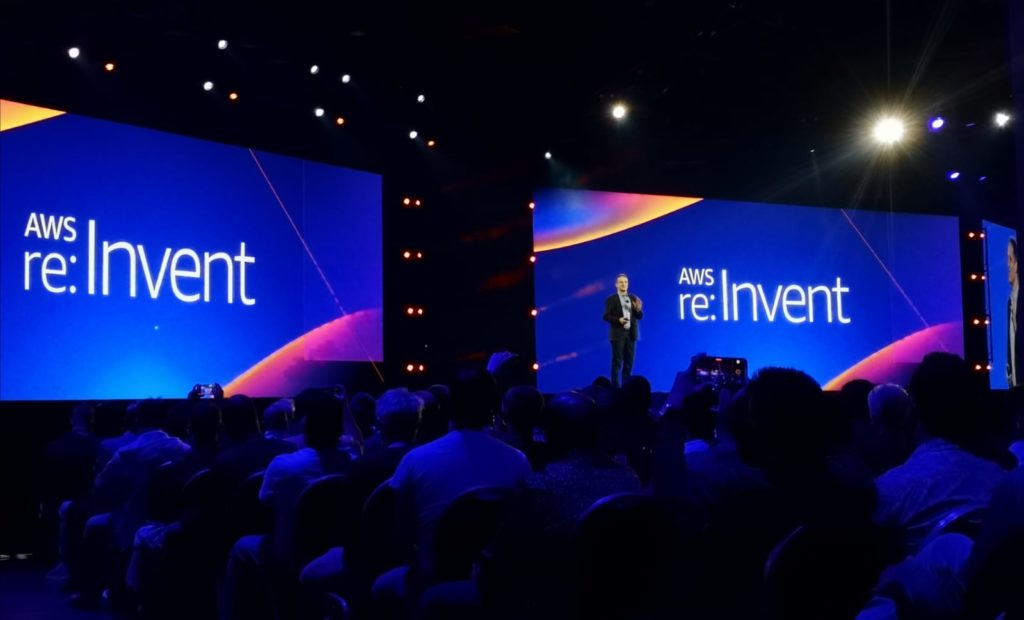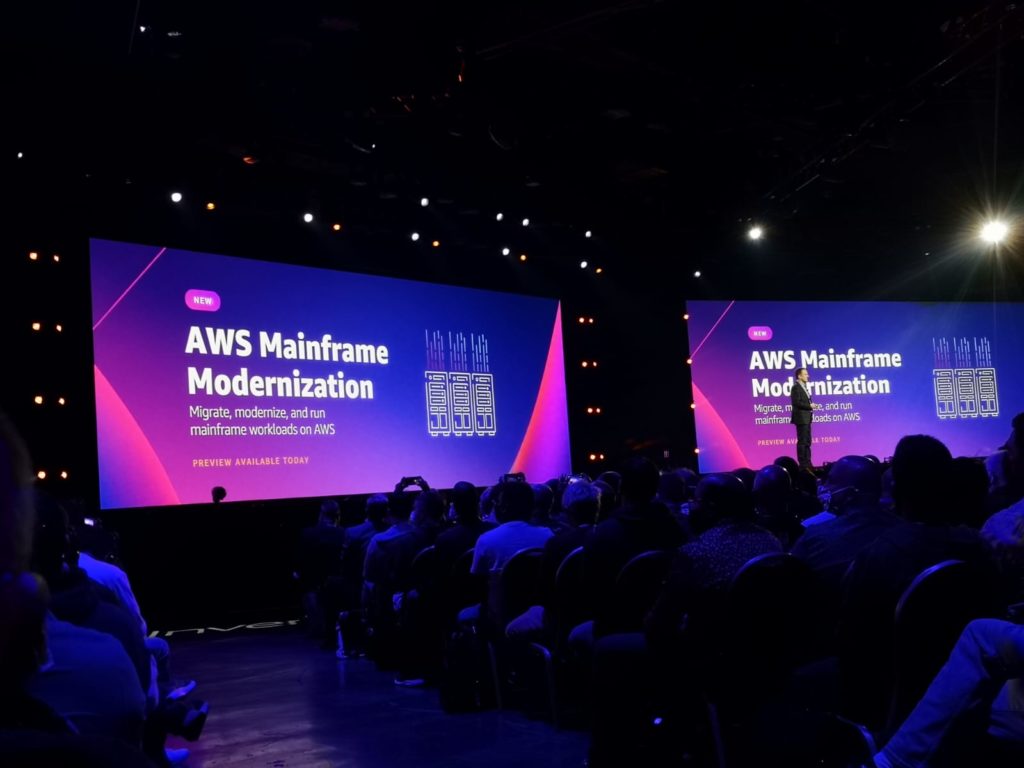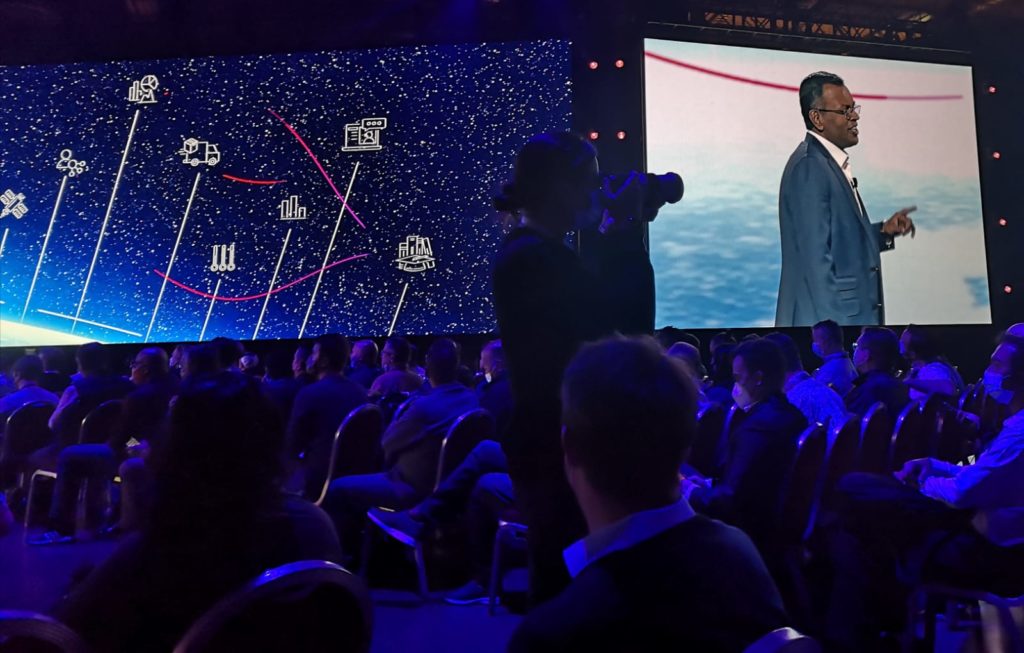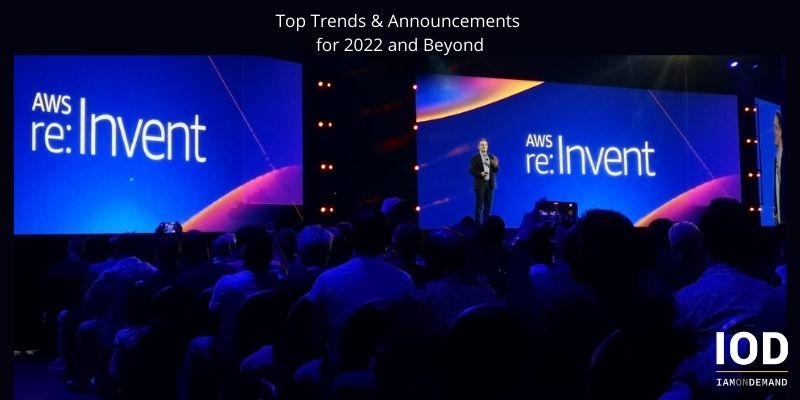AWS is going horizontal… and vertical, focusing on use cases and building simplicity and user-friendly tools into the mix. That’s according to keynotes delivered by brand-new AWS CEO Adam Selipsky, VP of AI Swami Sivasubramanian, and VP/CTO Werner Vogels. IOD was thrilled to be live on the ground at AWS re:Invent 2021 in Las Vegas from Nov. 28 to Dec. 2, and our biggest takeaway was that even with this year’s reduced format, re:Invent is still setting the pace for the future of cloud.
Unlike 2020’s re:Invent, which was solely virtual, this year was held in a hybrid format, with sold-out tickets for in-person attendance (AWS isn’t saying how many people were actually there, but estimates range from around 15,000 to 28,000). It’s still a far cry from the 70,000+ that we saw in 2019, but the atmosphere was no less exciting and inspiring than in years past.
Obviously, there was way too much going on to cover it all. So we’ve distilled the main announcements, products, and services from this year’s re:Invent—as well as shared our insights into which developments are going to make the biggest difference to you in your day-to-day operations—whether or not AWS is your primary cloud provider.
Monday, November 29
The first day of the conference came with lots of little announcements and a few major ones. You can find a list of all the re:Invent 2021 announcements at AWS’ site, since there are too many to list here. Here below, we cover a few we think are going to make a difference in the cloud world over the short and long term.
With AWS Marketplace for Containers Anywhere, running containerized workloads just got easier—even on-premises. This makes it easier to discover containerized third-party apps and subscribe and deploy across a flexible range of environments. It also promises to simplify billing for these apps while providing security vetting and oversight, making them safer and easier to use.
Continuing with its trend of moving into spaces where third-party apps like Datadog and LaunchDarkly are thriving, AWS also announced new features for CloudWatch. First up is CloudWatch real-user monitoring (RUM), which helps developers monitor and analyze how apps perform in the real world so they can tweak the experience. Then there’s CloudWatch Evidently, which gives developers the ability to integrate A/B testing and feature flags for AWS apps. Some of this is already available in AWS AppsConfig, but CloudWatch Evidently aims to make this even simpler for faster enabling, disabling, and deployment.
Amazon CodeGuru also gets an interesting, if fairly minor, feature upgrade with Secrets Detector, which promises to improve detection of hardcoded secrets, consistently one of the major weaknesses identified by OWASP. This makes it easy to remove plaintext secrets and replace them with secret values stored in AWS Secrets Manager.
In a nice collaborative move, the AWS world opened up a little with the announcement of AWS Control Tower Account Factory for Terraform. Terraform has long been a leading player in configuration management and infrastructure as code; now, this new module adds the ability to implement custom templates and policies for individual accounts and organizational units (OUs), integrating Terraform into AWS Organizations for greater control and granularity.
Monday’s highlight: In more groundbreaking news, deploying Kubernetes clusters with AWS just got easier with the introduction of Karpenter. This open-source autoscaler, built on Helm, simplifies Kubernetes cluster balancing and resource allocation—improving performance while cutting costs.
Tuesday, November 30
It wouldn’t be re:Invent without a keynote from new AWS CEO Adam Selipsky, who took over this spring from Andy Jassy with Jassy’s move to become Amazon CEO. This year, it’s fascinating to note that AWS is emphasizing data scalability over cloud security, along with the need to focus on use cases in response to user demand.

Until now, AWS has focused its offerings at the cloud infrastructure level, but companies with limited ability to customize these offerings in-house will probably be seeing more horizontal use cases, such as out-of-the-box call-center functionality, along with industry-specific vertical use cases, solutions that will make it easier for companies to adopt AWS from end to end.
Here are a few highlights from Selipsky’s keynote.
Given that mainframes currently handle about 68% of mission-critical workloads, migrating these on-premises legacy workloads to the cloud is going to be a headache for a while. Now, the journey may become more accessible with the new AWS Mainframe Modernization platform. It analyzes and aids in the transfer of mainframe workloads, including replatforming and automated refactoring.

Serverless has been a popular buzzword for a couple of years now and one of the big Twitter hits of re:Invent 2021 was “Serverlesspresso,” AWS’s chance to spotlight serverless architectures while caffeinating the masses.
The high-tech coffee was accompanied by serverless announcements for four analytics services: Redshift, EMR, MSK, and Amazon Kinesis Data Streams. The new offering is an effort to meet user demand—removing headaches such as monitoring cluster size and performance—and keep up with competitors while offering a range of database products for every application. It’s been truly exciting to see all these serverless analytics options, and it’s easy to see why everyone will be scrambling to take advantage of the benefits.
Tuesday’s highlight: One of the great things about re:Invent is being on the ground for surprise announcements like the fascinating introduction by CEO Adam Selipsky of AWS Private 5G. The service, which is about to pilot in the US (sign up here if you’re interested), blurs the lines between private network and telco offerings, giving you more access to always-connected mission-critical, low-latency applications like IoT devices and operational technology like smart manufacturing across a larger geographical region. Instead of having to integrate offerings from multiple vendors, AWS says they’ll make it simple. Just click to specify the coverage and data capacity you need, and they’ll ship network hardware, including small-cell radio base stations and servers, along with all the SIM cards you’ll need to connect your devices. They’re promising simplified management, integrated with existing access and security policies. This is definitely one to watch over the next few months.
Wednesday, December 1
One of the major themes of re:Invent 2021 was celebrating 15 years of cloud, starting from the launch of Amazon EC2 in 2006. In keeping with Selipsky’s Tuesday keynote, a lot of the focus here was on going back to basics. AWS aims to offer a simplified journey for end-to-end data (Store + Access), analytics (Analyze + Visualize), and ML (Predict).

Wednesday’s can’t-miss keynote was Swami Sivasubramanian, AWS’ VP of AI. There are (no surprise here) a number of exciting developments coming down the pike when it comes to AI and ML. As usual, there are far too many to list here, but you can find them all summarized on the AWS blog.
There were multiple announcements of features coming out or available now for SageMaker, AWS’ “ML-for-all” at-scale platform, which first debuted in 2017 and is now used by tens of thousands of AWS customers. Three notable SageMaker developments announced by Sivasubramanian that take ML-for-all to a completely new level:
- SageMaker Studio Lab, which provides an accessible, user-friendly path into ML—part of AWS’ goal of training 29 million new AI and ML developers over the next four years.
- SageMaker Canvas, a visual, drag-and-drop ML interface that lets business analysts build machine learning models and generate accurate business predictions without learning code or having any ML experience.
- SageMaker Ground Truth Plus, a service that provides access to what AWS calls an “expert workforce,” a human labor pool that accelerates creation of ML training datasets fast and reduces costs by up to 40%.
In all the excitement over tech developments, we would be remiss if we failed to mention a $10M new AWS scholarship program that aims to help students from underrepresented backgrounds prepare for a future in AI and ML—a program in collaboration with Intel and Udacity. Creating opportunities and democratizing technology is not just a nice thing to do. As a society, we look to big companies like AWS to take the lead, making this low-tech announcement a big part of the feel-good experience at re:Invent.
All this investment in SageMaker and the future of AI/ML, according to Sivasubramanian, will let AWS customers “unlock the full potential of this technology to tackle some of the world’s most challenging problems.”
Fittingly for the 15th anniversary of EC2, there have been lots of EC2 changes announced, like a new Graviton3 chip and instance type, plus new EC2 instances for AWS’ Trainium machine learning chip. However, most of these developments seem iterative rather than revolutionary in and of themselves.
Wednesday’s highlight: DevOps Guru has been around since re:Invent 2020, but its capabilities have been expanded this year with the introduction of DevOps Guru for RDS, which allows developers working with Aurora (the fastest-growing device in AWS history!) to detect, diagnose, and resolve database performance issues. This product goes hand in hand with AWS DMS Fleet Advisor, which aids in the migration of database fleets to AWS, simplifying and automating what are often painstaking manual processes.
Thursday, December 2
Thursday’s keynote was a much-anticipated talk by Amazon VP and CTO Werner Vogels. One of the issues he spoke about most passionately is APIs. With half a billion API calls per second to the AWS IAM service, Vogels said, it’s important to look back on lessons learned over the last 15 years.
And leading the pack at #1 was “APIs are forever.” What a statement!
What that means is we need to focus on designing APIs for maximum security and usability, around clear and well-documented use cases. Too often, APIs are seen as an afterthought, from both functionality and security perspectives, but they are more important than ever—and becoming more so every day.

Vogels also stressed that AWS is here to offer the building blocks of cloud, an elegantly simple description of what most of us sense intuitively when exploring AWS’ range of core network services.
At the more philosophical end of the spectrum is the Builders’ Library, which includes a couple of manifesto-type pieces that make for worthwhile reading for all developers and IT professionals:
- “Reliability, constant work, and a good cup of coffee” on anti-fragility, complex computer systems, and the value of simple design, by Colm MacCárthaigh, AWS Senior Principal Engineer.
- “Making retries safe with idempotent APIs” on keeping apps simple and unbreakable by making sure you can retry calls without creating unwanted side effects, by Malcolm Featonby, AWS Principal Engineer.

Below, we cover a few announcement highlights from Vogels’s keynote.
AWS Amplify Studio, a low-code visual app development studio lets you build feature-rich, cloud-connected apps in hours instead of weeks, with full control over application code. And because it’s driven by Figma, the popular collaborative design tool, it lets designers work more closely with backend developers. It translates designs into React UI code; however, some coding knowledge is still required for full implementation.
Hot on the heels of Tuesday’s announcement of AWS Private 5G, AWS is introducing yet another networking innovation, AWS Cloud WAN, a service that taps into AWS’ servers to build, manage, and monitor connections between company locations all over the globe, relying on local providers only for the last-mile infrastructure connection to the physical site. One of the main selling points of the service is its integration with the centralized AWS dashboard, making it easy to automate network security tasks and policy.
Thursday’s highlight: One riveting announcement was the Sustainability Pillar, which joins the five existing pillars of the AWS Well-Architected Framework: Operational Excellence, Security, Reliability, Performance Efficiency, and Cost Optimization. The sustainability pillar offers advice and best practices for building sustainable applications. Cloud sustainability is a welcome concept that revolves around the principle of shared responsibility, surfacing best practices that embrace energy reduction and efficiency of all types of workloads. As a whole, the Well-Architected Framework strives to help create a balance of all six pillars through informed decision-making.
Now Go Build!
Through product and service offerings over the last year, it has become more clear than ever that AWS has made the leap from being focused almost exclusively on infrastructure to being a do-it-all vendor offering more and more specialized services—and Selipsky’s keynote drove that message home. While some may see this as AWS continuing to compete with its customers, in general, the developments we saw announced at re:Invent are filling legitimate gaps and serving use cases that have not yet been addressed. And we’re confident that every single participant went home inspired by Werner Vogels’ final cry, his personal catchphrase, “Now go build!”
Though not every single release announced at re:Invent 2021 is guaranteed to be a winner, there’s enough substance to the announcements to satisfy and intrigue us.
Whether through huge, long-term question marks like private 5G or the obvious, immediate use cases like SageMaker Canvas, AWS re:Invent is proof that what happens in Vegas doesn’t stay in Vegas—fortunately for all of us out here in the cloud world. Through re:Invent, AWS is STILL busy dreaming up the future of cloud.
Don’t miss out on our tech experts’ predictions and hopes published before this year’s edition of Amazon’s conference on all things cloud!

